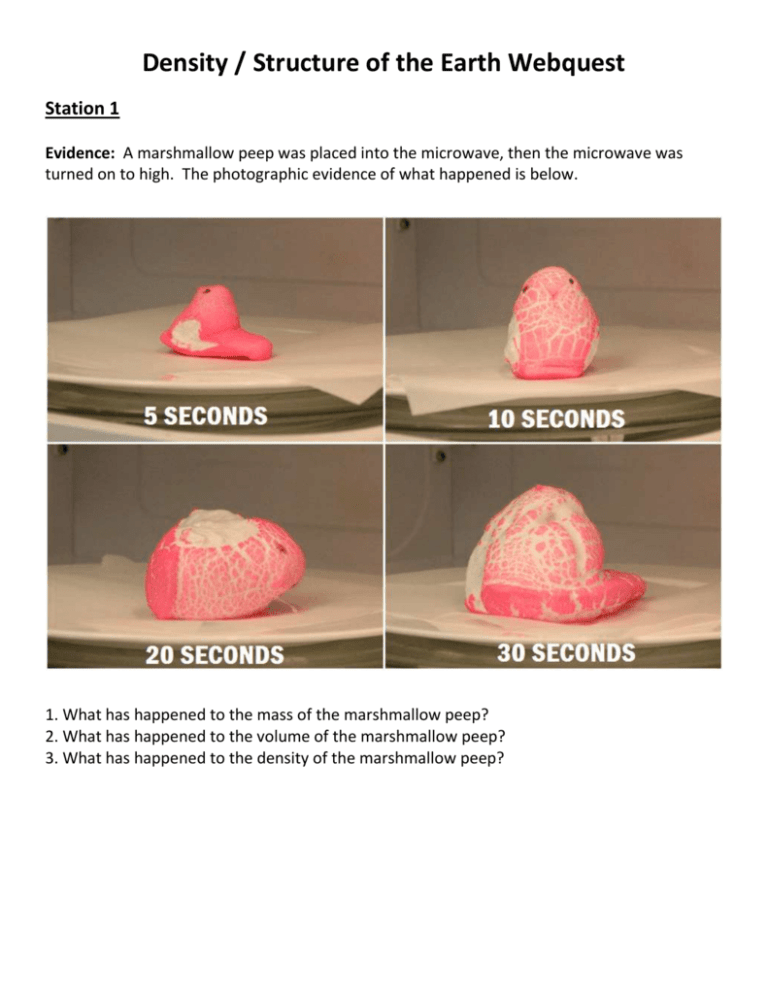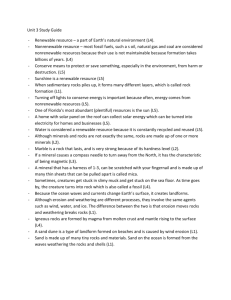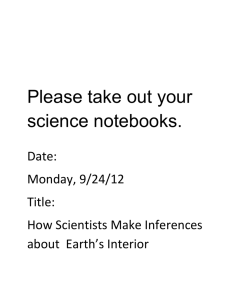Structure of the Earth Webquest
advertisement

Density / Structure of the Earth Webquest Station 1 Evidence: A marshmallow peep was placed into the microwave, then the microwave was turned on to high. The photographic evidence of what happened is below. 1. What has happened to the mass of the marshmallow peep? 2. What has happened to the volume of the marshmallow peep? 3. What has happened to the density of the marshmallow peep? Station 2 When you observe rocks in a stream or river, you often find they share common characteristics. The fast moving water moves rocks downstream. As the water slows down, the rocks slowly stop moving. Typically the largest rocks stop moving first while the smaller sized rocks continue moving until the water slows down even more. Below are pictures of six different-sized particles, made of the same type of rock. 4. Which particles will fall to the bottom of a fast-moving stream first? 5. Which particles will be carried downstream the greatest distance? Imagine that all of these particles fall from a river into Bear Lake. 6. Which particle will hit the lake bed (the bottom of the lake) first? 7. Where will most of the tiny grains be deposited? Station 3 Have you ever walked along a beach and wondered why parts of it were sandy and other parts were rocky? When the waves hit the beach, the sand and rocks carried in the water fall out. The denser rock particles are dropped first along the shore, while the less dense sand particles are carried further up the beach. 8. Which are the most dense particles in this jar filled with sediment from the beach? 9. If you want to walk barefoot along the beach, should you walk right at the water’s edge? Explain. Station 4 Use the on-screen calculator to determine the density of each of these substances. S ubstance M ass in grams Volume in cubic centimeters 10. Gold 193.2g 10 cm3 11. Oxygen 1.33g 100 cm3 12. Water 10.0g 10 cm3 13. Helium 1.663g 10,000 cm3 14. Mercury 67.75g 5 cm3 15. Copper 224g 25 cm3 Density in grams/cubic centimeters 16. Which substance would hit the bottom of a jar first? Station 5 What’s at the bottom of a stream or river can tell us a lot about how fast the water moves in the river. Slow moving rivers like the Mississippi are relatively flat, and the bottom of the river is covered with mud (silt) and sand. There are very few rocks because the water does not have enough energy to carry them along, and they soon get covered with sand and silt. Fast moving rivers have enough energy to carry small rocks downstream, and keep the sand and silt suspended (mixed) in the water as it flows downhill. The bottoms of steep, fast-moving rivers are covered with rocks, not sand. This biker is riding through a wash, where a stream once flowed. 17. Was this stream fast-flowing, slowflowing, or somewhere in between? 18. What evidence helps you decide? Station 6 Raised relief globe Flat surface globe 19. What differences seen when the two types of globes above are compared? 20. How is the raised relief globe a more accurate model than the flat surface globe? Look close-up photograph of the raised relief globe below. 21. Why is this not a good model? Possible model problems: Each globe is an attempt to show the placement and size of continents in relationship to the entire Earth. When you look closely at the raised relief globe, you see an attempt to demonstrate differences in elevation. Mountains are shown as being raised well above the Earth's surface. While it is true that mountains are higher than the average surface of the Earth, the scale does not match the globe. At the scale of a globe, the entire surface would appear flat. At this scale, when compared with the enormous size of the entire earth, even Mt. Everest would appear flat! Maps as models: When you look at a map, you observe relationships between parts of the Earth. Many maps are designed to allow you to place them on a wall. These large maps are very convenient models to use when observing the entire Earth at the same time. The major problem with maps as a model is that it distorts objects. Remember that the Earth is really round. When you flatten it out into a map form, it stretches out the poles and these areas appear larger than they really are. In the flat map above, Greenland appears to be about the same size as North America. It is, however, actually much smaller! 22. Why is a flat map not a good model of the earth? Station 7 If someone told you to figure out what in inside earth, what would you do? How could you use evidence to figure out what is inside our planet? How did scientists figure it out? Geologists study earthquake waves to “see” Earth’s interior. Waves of energy radiate out from an earthquake’s focus. These waves are called seismic waves. Seismic waves go different speeds through different materials. They change speed when they go from one type of material to another. This causes them to bend. Some seismic waves do not travel through liquids or gases. They just stop. Scientists use information from seismic waves to understand what makes up the Earth’s interior. Scientists also study meteorites to learn about Earth’s interior. Meteorites formed in the early solar system. These objects represent early solar system materials. Some meteorites are made of iron and nickel. They are thought to be very similar to Earth’s core. An iron meteorite is the closest thing to a sample of the core that scientists can hold in their hands. Earth has a magnetic field, so there must be metal within the planet. Iron and nickel are both magnetic and very dense, so we think they are the main components of the core. We know that the mantle is made of molten rock because of lava that oozes out of volcanoes. In addition, scientists have calculated the overall mass and volume of the earth, and thus the density of the whole earth. The density of the whole earth is higher than the average density of the materials in the crust, so the inside of the earth must be more dense than the crust. 23. Give one piece of evidence from the information above that explains how we know that the outer core of the Earth is a liquid. 24. Give one piece of evidence from the information above that explains how we know that the density of the inner core is more dense than other layers of the earth. 25. Give one piece of evidence from the information above that explains how we know that the mantle is plastic, molten rock.







